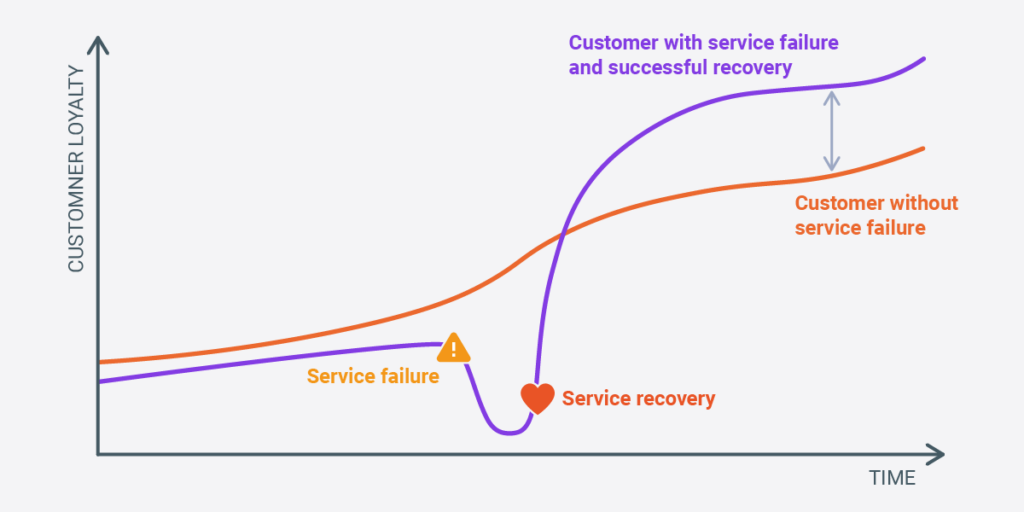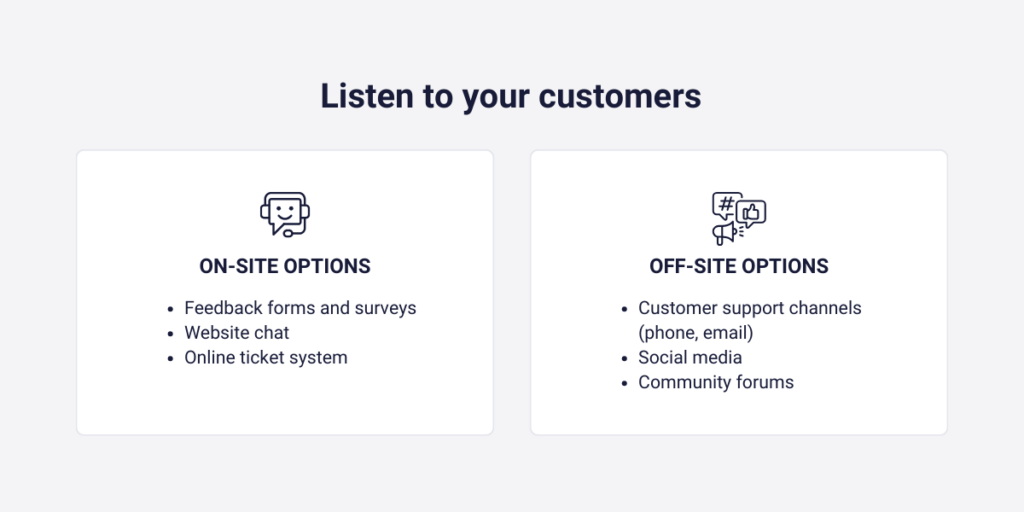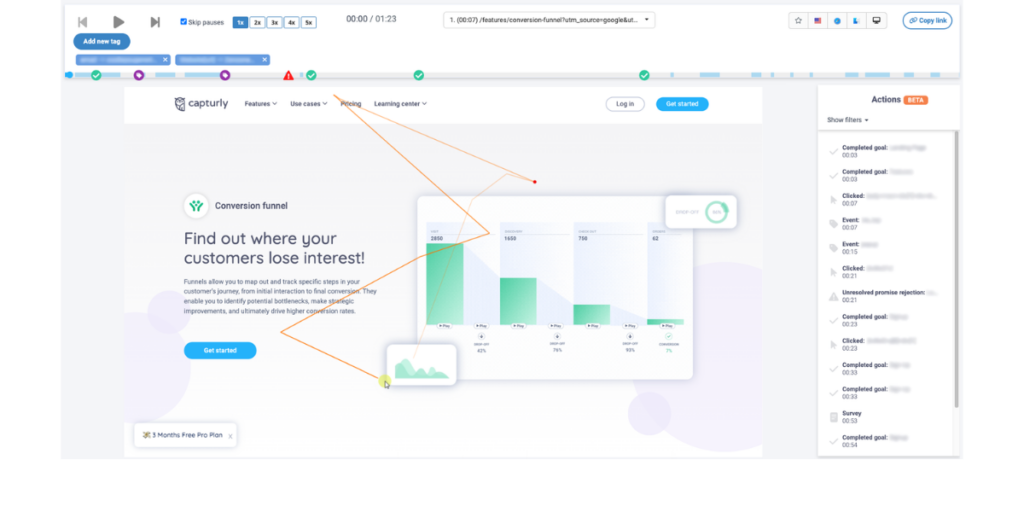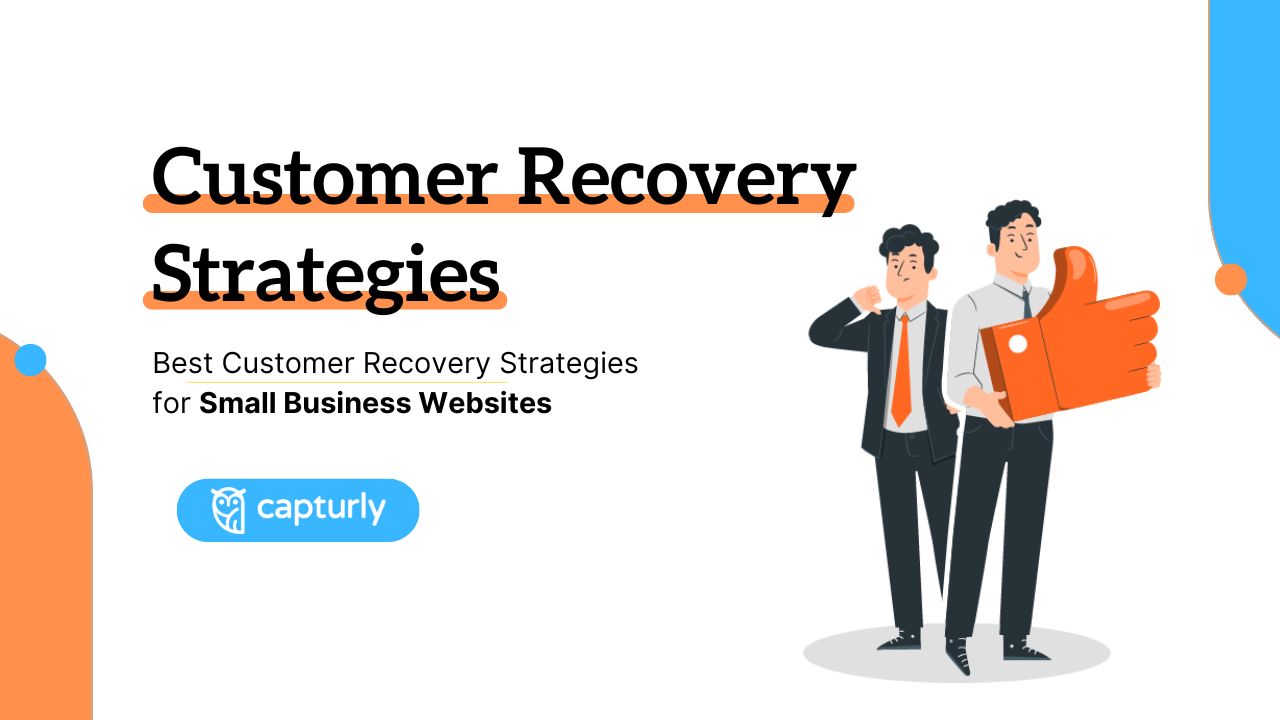You can’t avoid mistakes. It’s always with us, even if we work so hard to avoid all of them. Unhappy customers show up in the blink of an eye, and they switch your site with another too quickly.
They are not interested in compensation, nor want to wait weeks for you to solve their problems. They are angry and furious, and humans tend to not think rationally in these times. Although there are some customer acquisition strategies for small business websites, generally you can’t always stick with new and new buyers. Since, as you may all experience, for a small business website existing customers are everything. Studies show that it is 5-7 times more expensive to convince new buyers of a possible purchase than the remaining buyers.
Also, there are some other advantages to having loyal buyers. You can more efficiently predict the number of monthly sales, and order and store products based on that. On top of that, you can more precisely estimate your working capital, and work more smoothly, less likely to go to bankruptcy because of an outside “black swan event”.
In this article, we will show you what customer recovery exactly is, and how to handle bad experiences from your buyers. Don’t forget, buyers may be angry or not, no company would exist without the buyers, so the priority should be: do not let a single customer in trouble!
Table of Contents
What customer recovery is?
Customer recovery is the process of leading back frustrated, angry, and/or disappointed customers to your site. Their negative feelings are formed because of your site’s dysfunction, improper coworker behavior, an unfulfilled promise, or miscommunication. And the truth is: there can be a bunch of other causes. Sometimes you can’t even clear the actual problem, just the fact that the customer leaves your site with frustration.
Why is a customer recovery strategy for a small business website important?
Zendesk’s report pointed out that 50% of the visitors switch to one of the competitor’s sites, after just one bad user experience. If this number goes up to 2, this percentage reaches 80%!
We mentioned in the introduction part how hard it is to generate more traffic on your site. If it were only about advertising that would be cool, but even online advertisements can take too much financial resources. But for more and more revenue, great traffic is not enough. You need to reach out to those users, who can potentially buy your products. As – for example, in the real estate industry – visitors who don’t want to buy a house are worthless to you.
So, you need well-established target audiences, buying personas, defined platforms, and types of advertisements that help you to reach those that really matter. This is definitely not recommended for small businesses all the time.
The Service Recovery Paradox
Here, we need to mention something. A paradox, why customer recovery not only saves you important customers but also makes your relationship stronger with the disappointed buyer.
The service recovery paradox was first coined in 1992 by McCollough and Bharadwaj who discovered that there are better customer satisfaction rates after the company solves a problem connected to the customer, than in a situation where there is no problem at all.
Of course, you should never make mistakes intentionally. As we discovered earlier, there’s a big chance that dissatisfied customers go to your competitor’s site right after the mistake. However, if you can solve the customer’s problem immediately, you can even gain some profit from your mistake. So, if everything falls apart, think of this paradox! Who knows, some mistakes may form a stronger community than it ever was.

9 tips to make your customer recovery strategy better
Customer recovery concentrates on loyal, existing visitors, and their value maximization. Customers come and go, but with great tips and tactics, you can increase the time they spend purchasing from you. One of the tips is establishing an efficient customer recovery strategy. There are up and down moments in a customer-business connection.
In this chapter, we will share some tips with you about what you can do when the connection is at its lowest point. How to handle these emergencies, calm down the customer, and investigate the problem!
1. Listen to the customers
From 100 different online sessions, customers are not satisfied at least 38 times according to research. Well, most of the time, these are minor technical glitches that do not influence their buying experience too much. But, there are major bugs, and if you handle all problems as: “Don’t worry, there are other ways to get there, they will solve it, if they really want” – Like, in this case, you shouldn’t be surprised, if the visitors get mad at you, and switch to other sites.
For an efficient small business customer recovery, you need to listen to your visitors. It seems easy, but you can’t hear their communication when they are facing the computer and browsing your site. It would be the best from the seller’s point of view, but it would be certainly concerning for obvious reasons.
Then, what are your options to hear their voice, and improve based on their reports? Well, there are a few, but we will share more information about them later in the article. Here, let us only mention the possibilities, without further comments on each! These are:
On-site options:
- Feedback forms and surveys
- Website chat
- Online ticket system
Off-site options:
- Customer support channels (phone, email)
- Social media
- Community forums

2. Create live chat support
Most of the time, the customers can find the exact same products on other websites. Of course, this is not certainly true for every industry, and company. But one thing is sure: every product has substitute products.
However, it takes a little time to switch sites. And several problems may occur after that: customers need to sign up for the site, understand its mechanism, or check its reliability.
So, they try to contact you first, and here are some issues:
- There’s no way to reach you
- There are several ways, but too slow, or personal (email, phone)
That’s right. Even if it is surprising, based on customer satisfaction there is a better way than answering problems via phone and email. And that is live chat support! A company measured how likely their clients give positive feedback after resolving an issue in different ways.
They measured the difference between the given answers in 5 different reaching possibilities (live chat, email, app, social media, phone). 82% of the buyers concluded that they were satisfied with the help of the live chat support function, while only 61% were glad about email problem solutions, and only 44% with phones!
Small businesses can even save money with this implementation: they don’t need to establish big call centers to receive numerous calls from frustrated customers at the same time. With well-equipped live chat support, you can even communicate with 6 customers at a time. Also, it’s easier to explain the problem, and you can send screenshots to lead them through their route successfully.
3. Don’t be too proud to apologize
Sometimes, it’s too hard to apologize. The problem that occurred is not your fault completely, or partly, or you can’t even imagine how that tiny mistake meant that much to the customer. But, what if I tell you that apology is needed in small business customer recovery?
Well, even if these are true, don’t play the blame game. It’s like when you have an oral exam, and know nothing about the topic, but highlight to the teacher that: the bus arrived later and you got out of focus, so you lost everything that you stored inside your head. Have these ever helped you? You know the answer!
A genuine and empathic apology means so much more. It helps you recover those customers that you almost lost. Of course, while you take the blame on yourself, you need to work hard to solve the issue. In addition to that, first, detect and solve the problem immediately (we will talk about this part later), and then make contact with the potential buyer.
“We understand how crucial it was for you to make that sale, and we deeply regret the problem you experienced. We have worked diligently to repair the mistake, and you can now fully access our features. We truly hope our efforts to correct this issue allow you to see our commitment to your satisfaction!”
In this example, you not only apologize politely, but you bring the solutions with you. This is the most efficient way to communicate with your users in a situation like this.
4. Detect the root of the problem
However, as long as you don’t discover the problems, speaking with your mad clients just makes them more frustrated.
“Until you wrote this message, you would rather concentrate on solving the issue, and I would be so happy!” – Many of them think the same. But, how can you find the root of the problem? Don’t forget, you don’t have too much time to stop them from choosing another brand.
The best way to reach that is going with data analytics tools. These tools record, store, and re-play visitors’ clicks, scrolls, and other behaviors to later discover patterns and possible negative scenarios. For customer recovery, the best function is the session recording software by miles. We will demonstrate its effectiveness for small business customer recovery through our data analytics tool: Capturly Analytics.

One of the best features of Capturly which is not standard across their competitors currently is the connection between their session recording tool and the conversion funnel analysis function. Let us explain it to you. The conversion funnel analysis tool indicates what types of conversion each user is heading to, and what step the user is currently in. But, we can also detect at what step the customer turned its back, and get out of achieving the conversion.
The thing is, with Capturly you can identify which customers get bounced from the conversion, and you can rewatch their sessions, with the help of the session recording software. With that, you will not only understand why the customer gets bounced. Our tool is capable of identifying different problems connected to the website’s code, so you can figure out the root of the problem immediately.
This is a good option for small business customer recovery, as using our tool is completely free! You only need to change to one of the paid plans, if your website grows bigger, with more traffic.
5. Track rage clicks, the absolute indicator of an issue
What if you get a certification that something ain’t cool? It’s not always easy to figure out from the combination of session recordings, and conversion funnels that there is a problem. Not all of the users are dissatisfied with your website, product, or other factors when they get bounced from the funnel. Maybe, they are just thinking about the decision for a few more days, or the user realizes that it’s not the product that the user wanted to get.
It’s too resourceful for a small business website to analyze all of these bounces, and filter the unsatisfied clients. Although there is no other way to do that, a rage click can indicate some human behaviors that typically mean anger and dissatisfaction.

Rage click is when the user repeatedly taps or clicks a website element in a quick time frame. Imagine this scenario, what’s the meaning of this behavior? If a website element works perfectly, we don’t click on that more than two times. This behavior indicates anger, and frustration potentially because something doesn’t work the way it should.
It may mean that:
- Not clear whether an element is clickable or not
- Broken buttons
- Invisible overlays
- Misleading content
These all can lead to potential rage clicks. However, these problems can cause more than a short frustration, because it’s not obvious that after this behavior everything goes back on track. The effect of these issues can be so enormous, which leads the users to switch your site to one of your competitor’s sites.
Luckily, Capturly’s session recording tool can identify these patterns and indicate them in every stored session, where this movement appeared. Thus, you can easily find out your broken elements, and categorize those clients that are potentially still dissatisfied with your website, or your business itself.
6. Convince the dissatisfied clients with email surveys
Sometimes, your visitors don’t write anything to you about the mistake. Of course, you can track that the visitor made some rage clicks, but you no longer find the potential buyer on your site. In this case, the user has no intention to use your site again, and it may seem that you lost all of your chances to contact the user.
Well, that’s not the case. You still have an option, you only need to have the user’s email address with you. On Capturly Analytics, we provide a survey option, which exists to detect dissatisfied buyers who no longer use your website, and get a general view of how satisfied were our buyers with the service.
But, even if some data analytics company’s survey option is not too in-depth, and only good for calculating Net Promoter Scores, Capturly’s version is different. Here, you can compose individual introductions, and a Thank you page, with customizable pics, titles, and texts. On top of that, you can write answer types, and rating types questions to completely analyze the user’s problem, fix the mistake, apologize, and offer some initiatives to make their day better.
According to Gitnux.org, the average email response rate is 33%, but you can even improve that number. With Capturly, you can even automate at what time you want to send the survey to the customers (statistics show that it is better to send email surveys on weekdays, between 3 pm and 6 pm), which is a powerful feature!
7. Offer personalized deals
So, you finally reached your unsatisfied client, detected the client’s problem, and also made a very deep apology. But, these are not always enough. Visitors want to get something in exchange for their time, patience, and forgiveness.
However, that doesn’t always necessarily mean you need to get the stares from space to somehow demonstrate your remorse.
- A strategy can be for example, if you offer them a token in exchange for referring a friend. In this case, if one of their friends signs up on the page, and writes down the code, the recently unsatisfied customer gets an 80% discount for one of the products.
- Another way to give them a surprise, but also encourage them for later purchases, is to make their shipping free. In this case, they can still increase your revenue, but they also feel like you care about them.
- One other way – if you have a loyalty system – is to give them a lot of points. With more and more points they can get access to better deals, or exclusive products. With the help of that, they not only get a free product, and after redeeming it, you never hear from the user again. On the opposite of that, here the user needs to purchase some products later on to earn even more points for better deals.
Even if these were the most popular ideas, the number of possibilities is almost infinite. You can recommend free complementary products to the next purchase, provide a “buy one, get one” deal, or invite them to a special event.
Sometimes the chosen strategy must depend on your target audience and the industry you are in. Also, awareness is key: do not offer deals that you can not sustain for the long term! You are a small business, with limited capabilities: you need to cook from the ingredients that you have!
8. Ask these customers frequently after the incident
Those customers who felt dissatisfaction with your site once, or more times in the previous months, need special care. They are not loyal anymore, and even if they still use your site, there’s a possibility that they switch to another one if they get targeted by other sites’ advertisements.
That’s why you need to focus on them, one by one. According to many researchers, customers really value personalization.
With this knowledge, you just need to decide the platform where you are gonna ask them later on. We already spoke about email surveys, but we need to emphasize their importance more.
These email survey programs offer you unique text options, and frequency options to those emails. What does that mean? First of all, you can personalize the email the way you want. There’s no tie on your hands, so you can use their name in the introduction (automation tools are eligible to insert that without searching for the names one by one). Secondly, you can set a frequency. Do you want to thank the user for still using your site, and give some rewards due to the user’s persistence? Well, you can set a one-month frequency, and the email will be delivered to the buyer once every month for a designated period.

You have some other options, as well:
- Sending post-incident surveys repeatedly
- Regularly ask for feedback from these uncommitted customers
- In some industries, you can even send SMS-es, or check-in calls to regularly get informed by these customers’ current status with your business
9. Develop an action plan
We sorted out many must-have features for small business customer recovery, mitigating the risk of customer dissatisfaction and pointing out the problems leading to this behavior.
However, you can’t add every option to your customer recovery strategy. Our last tip is to create a simple, but effective action plan. An action plan contains your whole approach. From the beginning of saying sorry to the furious customer, to the very end, to choose the best deal that you can offer to the customer.
You have a whole variety of possibilities to choose from at each step, but when you try to tailor these tips to your own small business website, you will realize something. You can’t use everything, as you have a limited budget and human resources. Also, you can’t convince everybody, sometimes the best decision is to let the customer go. But, if you have a well-maintained customer recovery plan that you always need to follow, you will have better results in the long term. Consistency is the key to customer recovery!
Conclusion
In this article, we met with the real meaning of customer recovery and its importance. We also introduced a paradox which stated: it’s not always the worst possible scenario to have dissatisfied clients. But, you need to change their current state to happy, or at least a little bit less mad at you.
This is why we sorted out 9 individual tips to establish an efficient customer recovery strategy! With a well-equipped customer recovery strategy you no longer have to worry about minor website bugs. Put your hand on your heart, all of us make mistakes. But, it’s never about the mistakes, it’s about how we handle them, how fast we fix them, and how efficiently we communicate about them to our buyers.
Customer recovery is the process of leading back frustrated, angry, and/or disappointed customers to your site.
Customer acquisition is more resourceful than customer retention. That’s why loyal buyers are the key to growing bigger, and do not let your costs skyrocket.
Listen to the customer’s issue, and show empathy and remorse with your response. Meanwhile, find the route of the problem, and work on the solution.
There are various types of deals and incentives specifically for dissatisfied users.
For example:
– Coupon in exchange for referring a friend
– Free shipping on the next order
– Bonus loyalty points
– Free complementary products
– BOGO (buy one, get one) promotions
Businesses should follow up at multiple intervals, such as immediately after resolution, a week later, and then monthly for a few months.
Don't forget, sharing is caring! :)

